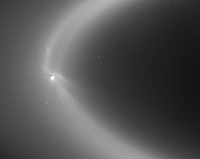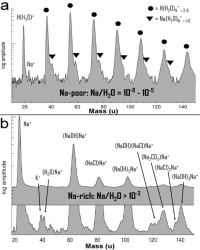Sodium salts point to subsurface ocean on Enceladus
25 June 2009
The Cosmic Dust Analyzer (CDA) on board the Cassini spacecraft has found sodium (Na) in varying concentrations in virtually all of its in-situ measurements of the water ice particles in Saturn's E ring. This has important implications for the icy moon Enceladus as the moon's south polar plumes are considered to be the main source of these E-ring water ice particles. In an article published today in Nature, Frank Postberg and colleagues conclude that the amount and type of sodium-bearing minerals found in the CDA measurements strongly favour the presence of a subsurface liquid water reservoir on Enceladus.
 |
|
Figure 1. Enceladus' plumes feeding the diffuse E ring. Credit: NASA/JPL/Space Science Institute |
CDA measurements
During Cassini's tour in the Saturnian system the CDA has taken thousands of in-situ mass spectra of the particles present in Saturn's E ring. These spectra reveal the different constituents of an ice particle based on the mass of ions which form after a hyper velocity impact (~10 kms-1) of the particle onto the instrument. Postberg and colleagues have analysed the CDA mass spectra and distinguish three main types based on the amount of sodium and organic compounds present:
|
Types of in-situ CDA mass spectra of icy E ring particles | ||
| Type | Description | Percentage of spectra |
| I | Almost pure water ice with traces of Na + K | > 90% |
| II | Water ice with organic compounds or silicates and traces of Na + K | |
| III | Water ice containing abundant sodium salts | ~ 6% |
|
About 3% of the spectra have intermediate sodium abundances | ||
 |
|
Figure 2. Example CDA mass spectra of types I&II (a) and type III (b). |
Laboratory mass spectra of different sodium solutions with different sodium concentrations were obtained and compared with the CDA mass spectra by Postberg and his team. Solutions that produced mass spectra matching those of type I and type II required a low Na concentration with a sodium/water ratio of Na/H2O
Subsurface ocean
The high concentrations of sodium and the identified sodium minerals in type III mass spectra lead the authors to infer the presence of a slightly alkaline sodium salt water reservoir enriched in carbonates (CO32-) beneath the surface of Enceladus. The water reservoir could even be linked with a subsurface ocean.
 |
|
Figure 3. Possible condensation mechanisms in ice vents, resulting in different sodium concentrations in grains. |
Since only liquid water can contain significant amounts of salts the authors suggest that the sodium-rich water-ice particles (type III, which contain about 1% salt) are directly frozen droplets from the liquid phase [Figure 3a]. The salts must have been leeched out from rocky material within Enceladus. This points to an interface between the hot rocky moon core and the ocean. However, whether the water that feeds the Enceladus plumes is still in contact with the core cannot be determined from these CDA measurements. The frozen droplets are sub-micron sized and additional water vapour condenses on them as they travel upward through the plume ice vents in Enceladus' ice crust.
The other two types of particles that contain mainly water ice and only traces of sodium (type I and II) can also be explained with a scenario that involves a subsurface ocean. These particles form after evaporation of the salty ocean that leads to nearly pure water vapour and only very low concentrations of salts in the particles after they are frozen and vented out in the plumes [Figure 3b].
Related publication
Postberg, F. et al., "Sodium Salts in E-Ring Ice Grains from an Ocean below the Surface of Enceladus", Nature, Vol. 459, Issue 7250, pp 1098-1101, 25 June 2009, doi:10.1038/nature08046



